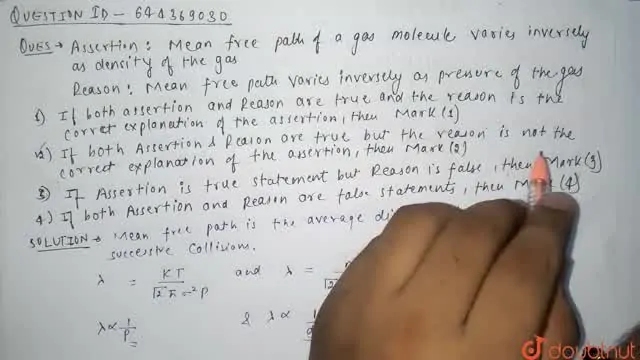Assertion : Mean free path of a gas molecule varies inversely as density of the gas.
Reason : Mean free path varies inversely as pressure of the gas.
If both Assertion & Reason are true and the reason is the correct explanation of the assertion, then Mark (1)
If both Assertion & Reason are true but the reason is not the correct explanation of the assertion, then mark (2)
If Assertion is true statement but Reason is false, then mark (3)
If both Assertion and Reason are false statements, then mark (4).
The correct Answer is:B
Step by step video & image solution for Assertion : Mean free path of a gas molecule varies inversely as density of the gas. Reason : Mean free path varies inversely as pressure of the gas. by Physics experts to help you in doubts & scoring excellent marks in Class 12 exams.
Related Playlists
- BOOK - AAKASH INSTITUTE ENGLISHCHAPTER - KINETIC THEORYEXERCISE - EXERCISE (ASSIGNMENT) SECTION - C Previous Years Questions21videos
KINETIC THEORY
- BOOK - AAKASH INSTITUTE ENGLISHCHAPTER - GRAVITATION EXERCISE - ASSIGNMENT SECTION - D (ASSERTION-REASON TYPE QUESTIONS)15videos
GRAVITATION
- BOOK - AAKASH INSTITUTE ENGLISHCHAPTER - LAWS OF MOTIONEXERCISE - Assignment (SECTION-D) (Assertion-Reason Type Questions)15videos
LAWS OF MOTION
Similar Questions
Mean free path of a molecule is
View SolutionThe mean free path of a gas molecule is the distance
View SolutionDefine mean free path .
View SolutionWhat is the meaning of pressure of the gas?
View SolutionThe mean free path l for a gas molecule depends upon diameter d of molecule as
View SolutionDefine free path and mean free path.
View SolutionIf diameter of gas molecule is d then mean free path is inversely proportional to
View SolutionThe mean free path of collision of gas melecules varies with its diameter (d) of the molecules as
View SolutionThe mean free path of molecules of a gas (radius r) is inversely proportional to
View SolutionOn increasing number density for a gas in a vessel, mean free path of a gas
View Solution


